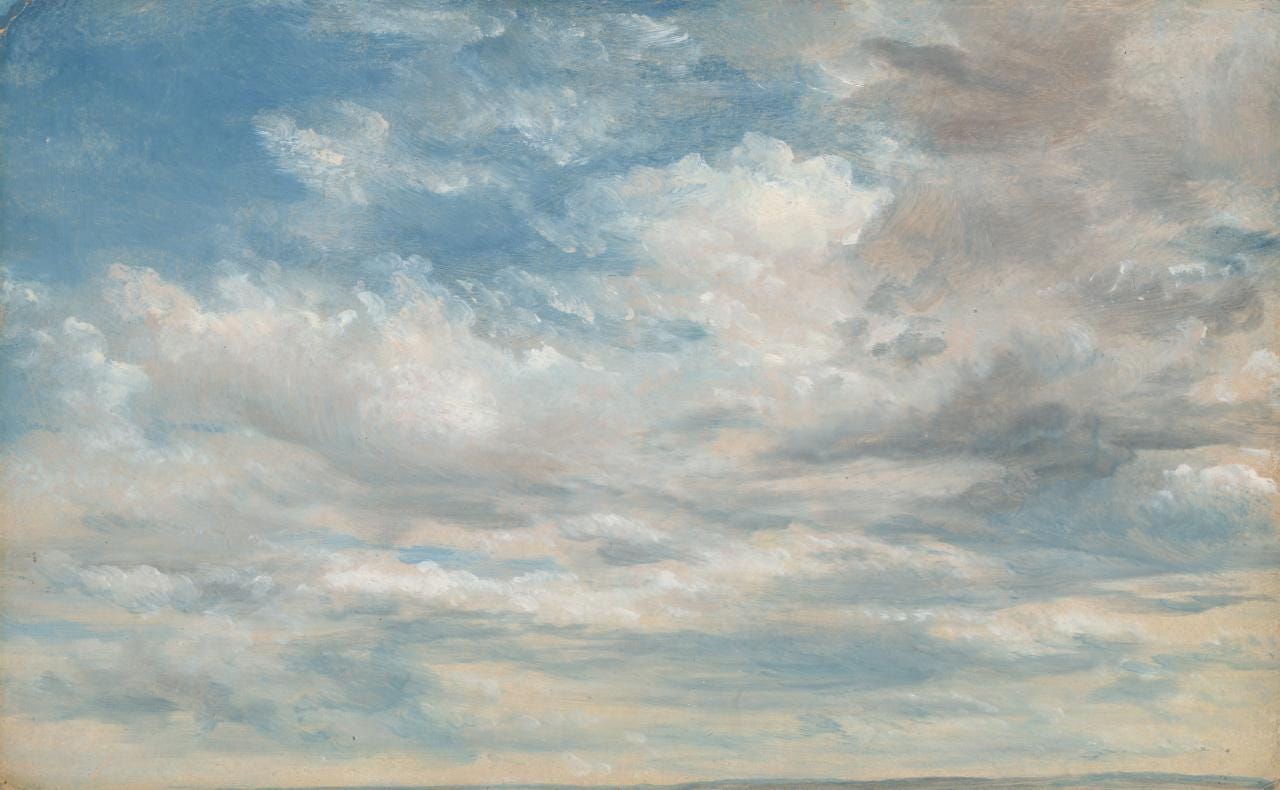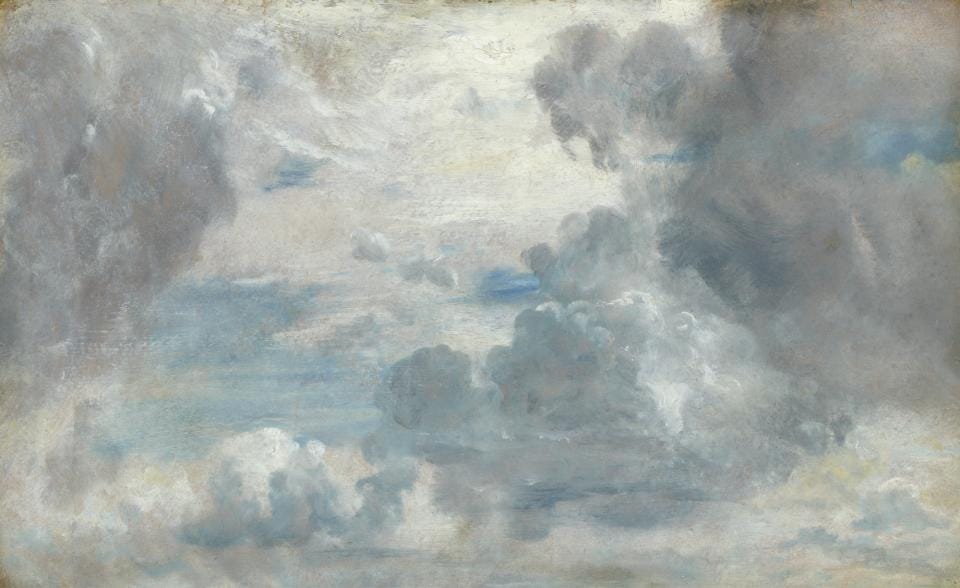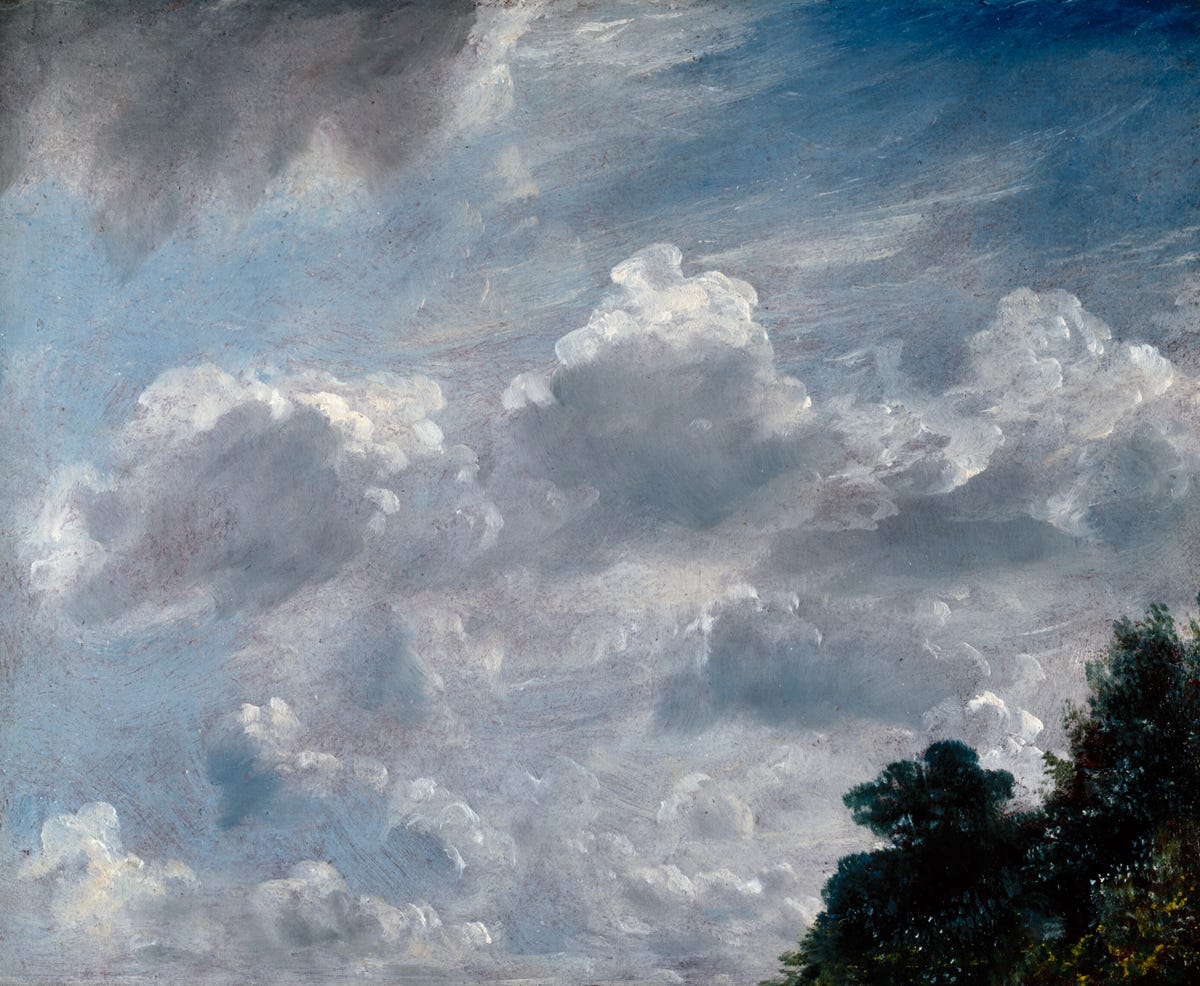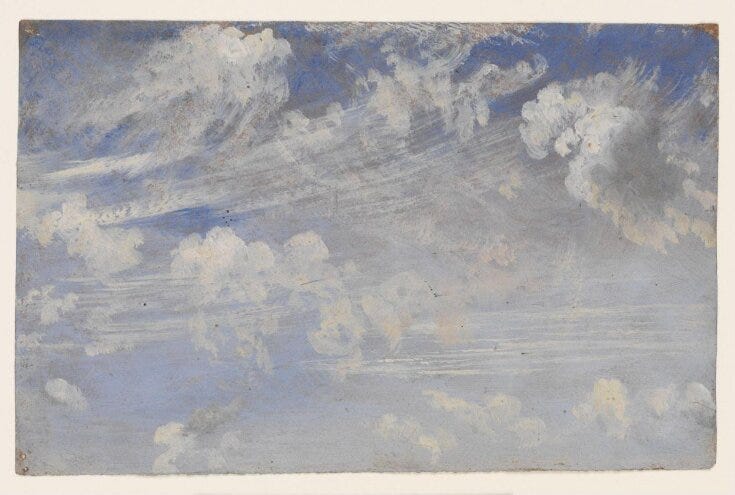The Grandfather of Cloud Art - John Constable
Uncovering the significance behind the cloud studies that continue to influence artists today.
When we think of clouds in art, it's easy to picture serene landscapes with fluffy white formations drifting across a calm blue sky. But for John Constable, clouds were more than just a backdrop—they became the subject of fascination, a lifelong study, and a reflection of the emotional and scientific curiosity of his time.
In 1822, Constable embarked on a remarkable series of cloud studies that would not only change how artists approached landscapes but also deepen our understanding of how the sky affects the mood of a painting. For me, Constable’s work feels like a bridge between the past and present—a reminder that the ephemeral beauty of clouds has captivated artists for centuries.
John Constable, Clouds, 1822, oil on paper on cardboard.
Inscription inscribed in pen and ink on paper label on reverse: 5 Sepr 1822. / 10 o clock Morng. looking South-East. / very brisk wind at West. / very bright + fresh Grey (inverted v under Grey) Clouds running very fast / over a yellow bed. about half way in the sky / very appropriate for the Coast. at Osmington.
Who Was John Constable?
Born in 1776 in East Bergholt, Suffolk, John Constable grew up surrounded by the rolling countryside of the English landscape. His father was a prosperous mill owner, and young Constable spent much of his childhood sketching the scenery of his beloved Stour Valley. These early experiences instilled a deep appreciation for nature, which would later become the cornerstone of his artistic career.
Constable’s work stood in stark contrast to the idealized landscapes popular during his time. While many of his contemporaries, like J.M.W. Turner, leaned toward dramatic, often mythological scenes, Constable sought to capture the raw, unfiltered beauty of nature. He believed that “painting is but another word for feeling,” and his landscapes reflected a deep emotional connection to the world around him.
Despite his passion, Constable’s career was not an easy one. His naturalistic style was met with skepticism by the Royal Academy, and widespread recognition came only later in life. Yet, his dedication to portraying the English countryside with honesty and precision never wavered.
The Hay Wain – originally titled Landscape: Noon – is a painting by John Constable, completed in 1821, which depicts a rural scene on the River Stour between the English counties of Suffolk and Essex.It hangs in the National Gallery in London and is regarded as "Constable's most famous image" and one of the greatest and most popular English paintings.
Why Did Constable Study Clouds?
By 1821, Constable had already established himself as a skilled landscape painter. But he felt that something was missing in his work—the dynamic movement and mood of the sky. He once wrote to a friend that “the sky is the source of light in nature, and governs everything.” This realisation led him to focus on clouds as a subject of intense study.
In the summer of 1822, Constable began an ambitious project: a series of oil sketches devoted entirely to the changing patterns of clouds over Hampstead Heath, just north of London. Over the next two years, he produced over 100 cloud studies, each capturing a different moment in time.
These studies were not just artistic exercises—they were scientific observations. Constable was deeply influenced by Luke Howard, an amateur meteorologist who, in 1802, had classified clouds into the now-familiar categories of cirrus, cumulus, and stratus. Howard’s work provided a framework for Constable to approach clouds not just as artistic elements, but as natural phenomena governed by observable patterns.
The Artistic and Scientific Importance of his ‘Cloud Studies’:
Constable’s cloud studies were groundbreaking for several reasons:
1. Precision and Observation
Unlike previous artists who treated clouds as decorative elements, Constable approached them with the precision of a scientist. His sketches meticulously recorded the date, time, and weather conditions, often including notes about wind direction and atmospheric changes. This level of detail allowed him to capture the ever-shifting character of the sky with astonishing accuracy.
2. Emotion Through Atmosphere
While Constable’s approach was scientific, his cloud studies also conveyed profound emotion. He understood that the mood of a landscape was deeply influenced by the sky—bright, billowing cumulus clouds evoked feelings of warmth and optimism, while heavy, brooding storm clouds suggested tension and foreboding. His ability to marry scientific observation with emotional resonance gave his landscapes a unique depth.
3. Impact on Landscape Painting
Constable’s cloud studies marked a shift in landscape painting. They encouraged future artists to pay closer attention to the sky, inspiring movements like Impressionism where artists like Monet and Pissarro sought to capture the fleeting effects of light and atmosphere. Constable’s insistence on painting what he saw, not what was imagined laid the groundwork for a more honest, naturalistic approach to landscape art.
Notable Works:
Many of Constable’s cloud studies remain in private collections, but a few notable works can be viewed in public galleries:
“Cloud Study, Hampstead, Tree at Right” (1821-22) – A masterful depiction of soft cumulus clouds drifting across a pale blue sky, this study captures the calm, breezy atmosphere of a summer’s day.
“Cloud Study, Stormy Sunset ” (c. 1821-1822) – captures a dramatic moment at Hampstead Heath, where dark storm clouds loom over a sky streaked with warm, fading sunlight. Painted with loose, expressive brushstrokes, Constable conveys the turbulent energy of the atmosphere, blending scientific precision with emotional intensity. This study highlights his mastery of observing and translating the fleeting moods of the sky.
“Study of Cirrus Clouds” (1822) – This study captures delicate cirrus clouds stretching across a serene sky. Painted in 1822, it exemplifies Constable’s meticulous observation of cloud formations and weather patterns over Hampstead Heath.
Constable inscribed 'cirrus' on the reverse of this sketch. It shows his countryman's understanding of the weather. He also owned a copy of Researches about Atmospheric Phaenomena by Thomas Forster. It was published in 1815 'with a series of engravings, illustrative of the modifications of the clouds'.
These works highlight the variety in Constable’s cloud studies—from tranquil skies to turbulent storms—revealing his nuanced understanding of how the atmosphere shapes our perception of nature.
Why Constable’s Cloud Studies Matter Today:
I often think about how Constable’s approach to clouds resonates with the work I do today. While I use 3d software to simulate cloud formations, the essence remains the same—observing, understanding, and capturing the fleeting beauty of clouds. Constable’s work reminds me that, despite the tools we use, truly seeing the sky and being able to create a natural depiction of it requires patience, curiosity, and a lot of practice.
His cloud studies also encourage us to slow down and appreciate the ever-changing sky. In a world where we are constantly bombarded with digital distractions, taking a moment to observe the clouds—whether through art or in real life—can be a grounding, almost meditative experience.
Final Thoughts:
John Constable’s cloud studies may have been created over 200 years ago, but their relevance endures. They remind us that art and science are not so far apart, and that understanding the world around us—whether through oil paint or 3D rendering—can deepen our appreciation for its beauty.
As I embark on this journey of exploring clouds in art through history, I invite you to join me. In future articles, I’ll be delving into the works of other artists who have been inspired by the sky—from the luminous cloudscapes of J.M.W. Turner to the atmospheric studies of Monet.
So, if you’ve ever looked up at the sky and wondered about the art of clouds, subscribe below and stay tuned!
Want to see more of Constables work?
Check out this pinterest board to see how truly masterful John Constable was at painting clouds.
Subscribe for More Cloud Art Explorations
If you enjoyed this exploration of John Constable’s cloud studies, be sure to subscribe for future posts. Every month we’ll uncover a new artist who has made an effort to capture the ever-shifting beauty of the sky.
The Art of Clouds is a monthly newsletter exploring artists throughout history who were inspired by clouds. Each issue sheds light on an artist and their work, uncovering how they captured the sky as a subject and symbol.
Curated by Marc Whitelaw, the artist behind Break Your Crayons.







